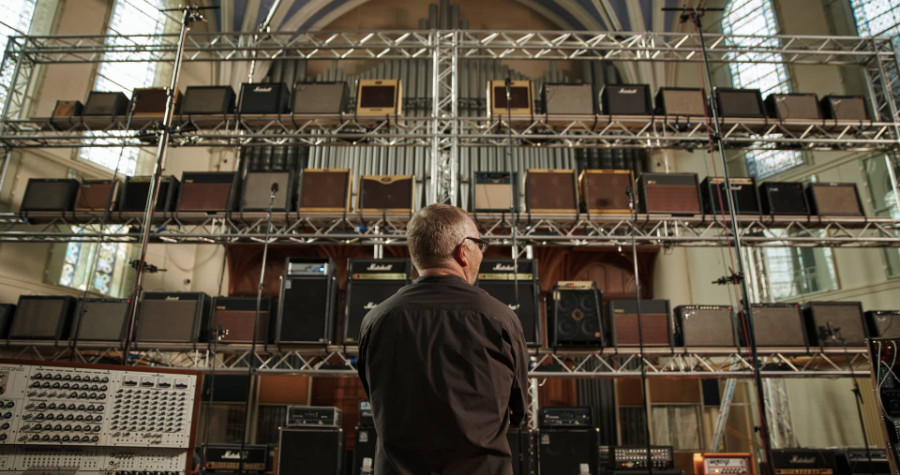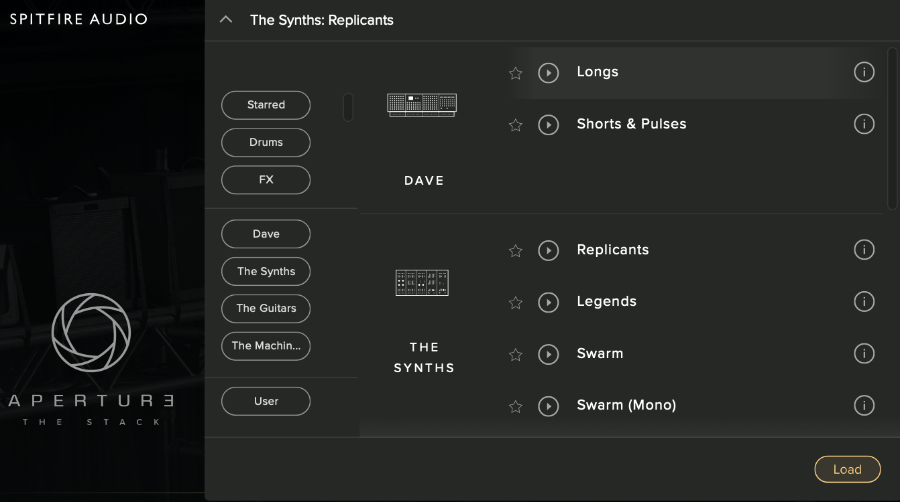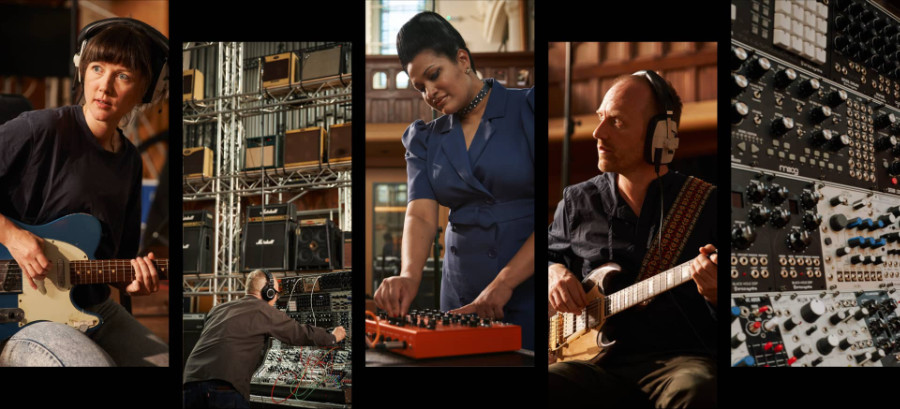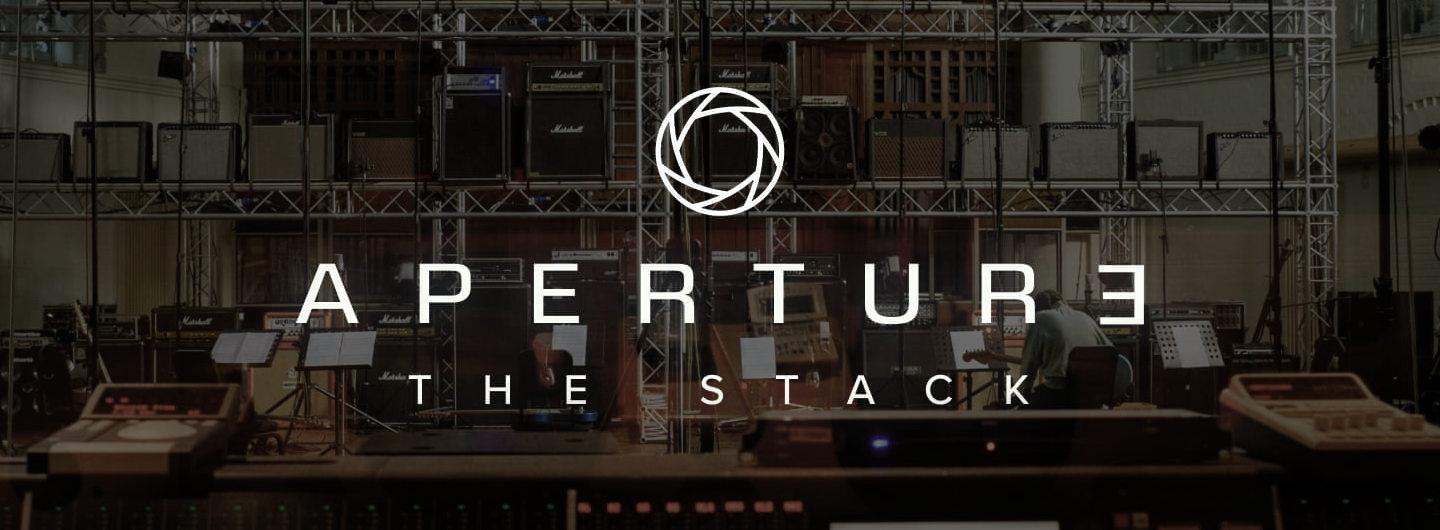Define hyperbolism: a giant (and world record-breaking!), four-level rack of 56 guitar amps, 4 subwoofers, and a priceless collection of analog synthesizers, all recorded in one of the world’s most sought-after recording spaces in the world. Today we’ll be checking out what is quite possibly one of the most insane creations of Spitfire Audio to date: The Stack.
As part of their Aperture series of sample libraries, Spitfire released Aperture: The Stack during their annual Black Weekend campaign and wowed the entire composer community with the sheer, stunning scope of this project. The team around Christian Henson and Paul Thomson went out to London’s famed AIR Lyndhurst Hall again, but this time, it wasn’t about pristine orchestral recordings at all. Spitfire Audio’s goal was to capture an enviable collection of vintage synthesizers, drum machines, and performer ensembles through a giant wall of amps that would not only shake the foundations of one of London’s top recording spaces.
Let’s check out together what Aperture: The Stack is all about!
OVERVIEW
Aperture: The Stack is a sample library designed for Spitfire Audio’s own, proprietary sampler plugin. The library features recordings of various groups of analog, vintage, and modular synthesizers, a classic drum machine as well as an ensemble of coveted electric bass and guitar players.
These instruments were captured in many different playing styles for The Stack:
- 1x Analogue Solution Colossus
- 8x Soma Laboratory Lyra-8
- 1x Modular Eurorack Synth (aka The Wall)
- 2x Black Corporation Deckard’s Dream MK2
- 2x Roland Juno 6
- 2x Sequential Prophet
- 1x Roland TR-808 Drum Machine
- 2x electric bass players
- 4x electric guitar players
The basic idea of Spitfire’s Aperture series is giving the user full control over how small or big they want their sound to be. With The Stack, this means the player can seamlessly control how many amps a signal is fed through and therefore how three-dimensional the sound should be. With this many amplifiers, Lyndhurst Hall acts as a resonating chamber, so the more amps are active, the wider and further away the overall sound appears.
In order to realize such a logistically and technically challenging project, Spitfire Audio built a four-level scaffolding inside AIR Studios’ Lyndhurst Hall and filled it with all sorts of classic and modern guitar amps, bass stacks, and subwoofers. The microphones were set up in a way that the team could capture anything from an intimate, close sound to the big, reverberant hall of the stage.
The Stack takes roughly 7.5 GB of hard drive space and the convenient download and installation process takes place entirely in the Spitfire Audio download manager.

THE INTERFACE
With their recent releases, Spitfire Audio tends to move away from the year-long standard Kontakt format and design their libraries tailored to their very own sampler plugin format. Aperture: The Stack comes as its own plugin as well, although the look and functions of the interface are very similar to other Spitfire products like the BBC Symphony Orchestra, Abbey Road One & Two, or the Hans Zimmer Strings.
The interface is structured pretty clearly, with controls for expression, dynamics, and reverb up top and the articulation selection, effects, and utility functions at the bottom half. The big rotary knob controls the reverb amount by default but can be freely assigned to various other parameters instead like a cutoff filter, envelope shaping, and noise control.

A well-structured browser lets you search and choose between different instruments, categories, and articulations and also offers the option of playing back a small audio snippet of a patch before loading it.

THE APERTURE
You may find that the usual microphone selection we know from other Spitfire Audio products is missing. Since The Stack is part of the Aperture series, we don’t get any particular microphone positions to choose from but a dedicated “Aperture” control. Much like Spitfire’s “Easy Mix” in older Kontakt libraries, Aperture controls a whole array of different microphone positions with one single fader.
At its lowest position, you hear an almost dry signal, which is only running through a few amps in the hall, therefore keeping the room tone quite subtle. The higher you drive the fader up, the more amps are engaged and the room reverb and resonances become much more apparent. This was accomplished by gradually adding rows of amplifiers which each sampling take.
Since the microphones were moved farther away from the scaffolding with every row of amps, the overall sonic picture opens bit by bit, much like the Aperture works in a camera.
It almost sounds like you would slide back into a three-dimensional space. At the Aperture slider’s maximum position, you get a much louder and more massive sound of course but it also appears much more diffused because of the room. Where you were almost able to make out distinct amps in the beginning, now you get a big washy wall of sound that fills the whole spectrum.
THE INSTRUMENTS
Let’s find out what the team at Spitfire chose as sources to run through their gigantic wall of amps now. Pretty clearly, the main bulk of instruments sampled for Aperture: The Stack are synthesizers.
In the exquisite collection of instruments, we find some vintage classics like the Juno-6 and the Sequential Prophet. Spitfire also gathered some modern favorites like the beautifully unusual Lyra-8, the Deckard’s Dream MK2, or the humongous Colossus synth by Analog Solution.
Followers of Christian Henson’s Youtube channel will also recognize his custom, modular Eurorack synthesizer which makes an appearance as “The Wall”.

Since Spitfire clearly went for “bigger is better” with The Stack, they chose to not only send one synth at a time through the wall of guitar amps but doubled up on most of the devices. In the case of Soma Laboratory’s Lyra-8, they even got together a whopping eight units to perform as a group.
Speaking of groups, The Stack also featured some more human sound sources in the shape of two electric bass players and four electric guitar players who performed various playing techniques together. These were led by the experimental guitar innovator Leo Abrahams, who already contributed to several Spitfire Audio libraries in the past.
Lastly, we get a selection of classic drum machines like the TR-808 that were sampled through the array of 56 amps which obviously sound huge when they resonate through the large recording hall.
THE SOUND OF APERTURE: THE STACK
The Stack surely aims for a thick and wide screen-filling sound which is boosted into cinematic spheres by the lush hall sound of AIR Lyndhurst. The saturation and tube distortion of the individual amps doesn’t make everything sound harsh and aggressive but rather coats the signals into a rich and multi-faceted blanket of sound.
The lower register sounds in particular profit hugely from the amp array and Lyndhurst Hall sound, as both make the synth basses sound frighteningly powerful and larger than life. The inherently artificial sounds generated by the synthesizers seem to suddenly come into life and feel natural, organic, and “real”.
Although you might think that 56 amps and dozens of impactful sound sources would surely only amount to an aggressive wall of sound, the truth is that this would only be part of what The Stack is able to convey.
While searching through the different instrument groups and playing styles, you will also find particularly fragile and nuanced sounds that can make for beautiful sonic textures. Especially the guitar ensemble holds some very delicate textural sounds with the Scattered Soft or Cloud articulations leading the way.
CONCLUSION
With Aperture: The Stack, Spitfire Audio released a unique and specialized library that is unmatched so far. In the usual Spitfire line of things, both the sound quality and usability of The Stack are top-notch and inspire to get creative. In contrast to the first impression, The Stack doesn’t only do “loud”, but can also convey very delicate and soft textures if desired.
Now, will Aperture: The Stack become an essential, must-have tool for every media composer? I’m afraid not. But that’s fine. You can surely create amazing music without it, but if you’re looking for something special or an extra layer of musical pomposity, The Stack can be just the right cure.
Aperture: The Stack truly is a one-of-a-kind sample library and therefore not comparable to anything else on the market. It holds a place for its own until someone who is crazy enough tries to break the world record Spitfire Audio set for themselves with this project. The only question is: can it get any better than this? I doubt it.
Pros
- One-of-a-kind instrument collection and recording setup
- Excellent sounds from big & bold to fragile & delicate
- World-class scoring stage
- Clear user interface
- Aperture control works smooth and sounds convincing
Cons
- Quite specialized and probably not for every composer
- Due to the nature of the recording setup, some sounds need some post-processing to blend into the mix
RECOMMENDED: 8/10
Aperture: The Stack is available as a download through Spitfire Audio’s online shop for €249. Spitfire Audio also offers a free demo version of The Stack that allows you to check out some of the patches and the Aperture feature.


0 comments on “Spitfire Audio – Aperture: The Stack (Review)”